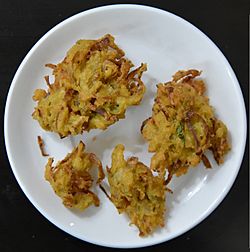Pakora facts for kids

Onion Pakodas, also known as onion bhaji
|
|
| Alternative names | Pakoda, pikora, bhajiya, pakodi, ponako, pakura, fakkura, phulauri, bora, chop |
|---|---|
| Type | Fritter |
| Course | Appetizer or snack |
| Place of origin | South Asia |
| Region or state | South Asia |
| Associated national cuisine | |
| Main ingredients |
|
| Variations |
|
| Similar dishes | Kyet thun kyaw Pholourie |
Pakora (pronounced puh-KAW-ruh) is a yummy, spiced fritter from the Indian subcontinent. Think of it as a tasty snack! You can find pakoras sold by street vendors and in restaurants across South Asia and the UK. They are usually made by dipping vegetables, like potatoes or onions, into a seasoned batter made from gram flour. Then, these coated veggies are deep-fried until they are golden and crispy. Pakoras are also called by other names like pikora, pakoda, pakodi, and regional names such as bhaji or bhajiya.
Contents
What's in a Name?
The word pakoṛā comes from an old language called Sanskrit. It combines two words: pakva, which means 'cooked', and vaṭa, meaning 'a small lump' or 'a round cake'. So, pakora basically means a 'cooked lump' or 'cooked cake'.
You might see pakora spelled in different ways, like pakoda or pakora. This is because of how the sound is written in different languages. Both spellings are correct and refer to the same delicious snack!
A Bite of History
Pakoras have been around for a very long time! Early versions of this fried snack are mentioned in ancient writings from Sanskrit and Tamil literature. These old texts describe them as 'round cakes made of pulse fried in oil' or 'crispy fried vegetables'.
The first clear recipes for pakoras appeared in cookbooks from long ago. One book, called Manasollasa (written around 1130 CE), describes how to make "Parika" (pakoda) using vegetables and gram flour. Another cookbook, Lokopakara (from 1025 CE), even talks about a special pakora recipe where gram flour is shaped like fish and fried in mustard oil.
How Pakoras Are Made
Making pakoras is quite simple and fun! First, different ingredients, usually vegetables, are chosen. These are then dipped into a special spiced batter. After they are fully coated, they are deep-fried until they become wonderfully crispy and golden brown.
Many different vegetables can be used to make pakoras. Some popular choices include onion, eggplant, potato, chili pepper, spinach, paneer (a type of cheese), and cauliflower. You can even find pakoras made with chicken or plantain!
The batter is most often made from gram flour, which is flour from chickpeas. Sometimes, rice flour is added to make the pakoras extra crispy. The spices used in the batter can vary a lot. Cooks often add fresh or dried spices like chili, fenugreek, and coriander to give them a delicious flavor.
Serving Up Pakoras
Pakoras are a popular snack or appetizer. They are often enjoyed with tasty dips like chutney or raita (a yogurt-based dip). Imagine dipping a warm, crispy pakora into a cool, tangy chutney – yum!
In India, pakoras are also a common treat served with masala chai (spiced tea) to guests at wedding ceremonies. They are perfect for sharing with friends and family.
Different Names, Same Delicious Snack
Depending on where you are, pakoras might have a different name! In places like Tamil Nadu and Sri Lanka, they are known as Pakoda or bajji. In Gujarat, they are called bhajia, and in Maharashtra, they are simply bhaji.
In Andhra Pradesh, Telangana, and Karnataka, you might hear them called bajji or "Pakodi". Sometimes, "Pakoda" in these areas refers to deep-fried balls made from finely chopped onions, green chilies, and spices mixed with gram flour. No matter the name, they are all delicious fried snacks!
Gallery
-
Pakoras in Jaipur
See also
 In Spanish: Pakora para niños
In Spanish: Pakora para niños













